Overview
The article titled "How to Explain Diabetes Type 2: A Step-by-Step Guide for Patients" aims to provide a comprehensive understanding of Type 2 diabetes. It thoughtfully explores the causes, symptoms, and management strategies, while also underscoring the importance of community support.
It's understandable to feel overwhelmed when faced with a diagnosis like this, and that’s why educating patients about key concepts, such as insulin resistance and hyperglycemia, is so vital.
This guide highlights how lifestyle changes, medication adherence, and emotional support play crucial roles in effectively managing the condition. You're not alone in this journey; many have walked this path and found ways to thrive. By fostering a supportive community, we can share experiences and encourage one another.
In seeking to empower patients, this article encourages you to take action by exploring available resources and support networks. Together, we can navigate the complexities of diabetes management, ensuring that you feel informed and supported every step of the way.
Introduction
In the modern landscape of healthcare, Type 2 Diabetes emerges as a significant challenge, impacting millions across the globe. This complex condition, marked by insulin resistance and elevated blood sugar levels, calls for a compassionate understanding of its underlying mechanisms, symptoms, and management strategies. As the number of individuals facing diabetes continues to grow, the need for effective education and community support becomes increasingly urgent.
It's understandable to feel overwhelmed. By exploring critical concepts such as:
- The importance of early detection
- The role of diet and exercise
- The significance of mental health
you can empower yourself to navigate your health journey with greater confidence. This article delves into the multifaceted nature of Type 2 Diabetes, offering insights and resources designed to enhance awareness and foster proactive management among patients and their families. Remember, you are not alone in this journey; we are here to support you every step of the way.
Understanding Type 2 Diabetes: Key Concepts and Definitions
Understanding diabetes type 2 can feel overwhelming, but it’s important to know that you’re not alone in this journey. This long-term condition is characterized by insulin resistance, which means your body struggles to use insulin effectively, leading to higher blood sugar levels. Often linked to obesity, diabetes type 2 typically develops gradually over time. For those newly diagnosed, grasping key terms like 'insulin resistance' and 'hyperglycemia' is essential for managing your health effectively.
Insulin resistance occurs when the body's cells become less responsive to insulin, the hormone that regulates blood sugar. As this resistance grows, the pancreas may find it challenging to produce enough insulin, which can explain the rise in blood sugar levels. Recent studies show that about 39.5% of adults diagnosed with diabetes type 2 have a non-HDL cholesterol level of 130 mg/dL or higher. This highlights the importance of managing both diabetes and cardiovascular health together.
Equally crucial is understanding hyperglycemia, which refers to elevated blood sugar levels. In the U.S., 8.0% of adults with a diabetes diagnosis have non-HDL levels of 190 mg/dL or higher, underscoring the need for effective management strategies. Case studies reveal that the age-adjusted incidence of diagnosed diabetes among U.S. adults has remained relatively stable, with rates of 6.2 per 1,000 in 2000 compared to 5.8 per 1,000 in 2021.
This stability suggests that while overall incidence rates have plateaued, there are significant variations across different regions. This indicates a need for targeted public health interventions to support those affected.
As we approach 2025, ongoing research continues to illuminate the relationship between insulin resistance and hyperglycemia. Recent findings emphasize the importance of early detection and intervention in managing diabetes type 2. Dr. Pankaj Arora notes that 'these screenings could easily be implemented in clinics nationwide in an effort to prevent deaths caused by these diseases.' This highlights the necessity for proactive measures in health care management.
Moreover, a joint webinar by WHO and the International Diabetes Federation is scheduled for World Diabetes Day 2024. This event will focus on breaking barriers and bridging gaps in care and education related to blood sugar management. By understanding these concepts, you can better navigate your health journey and make informed decisions about your care. Remember, we are here to support you every step of the way.
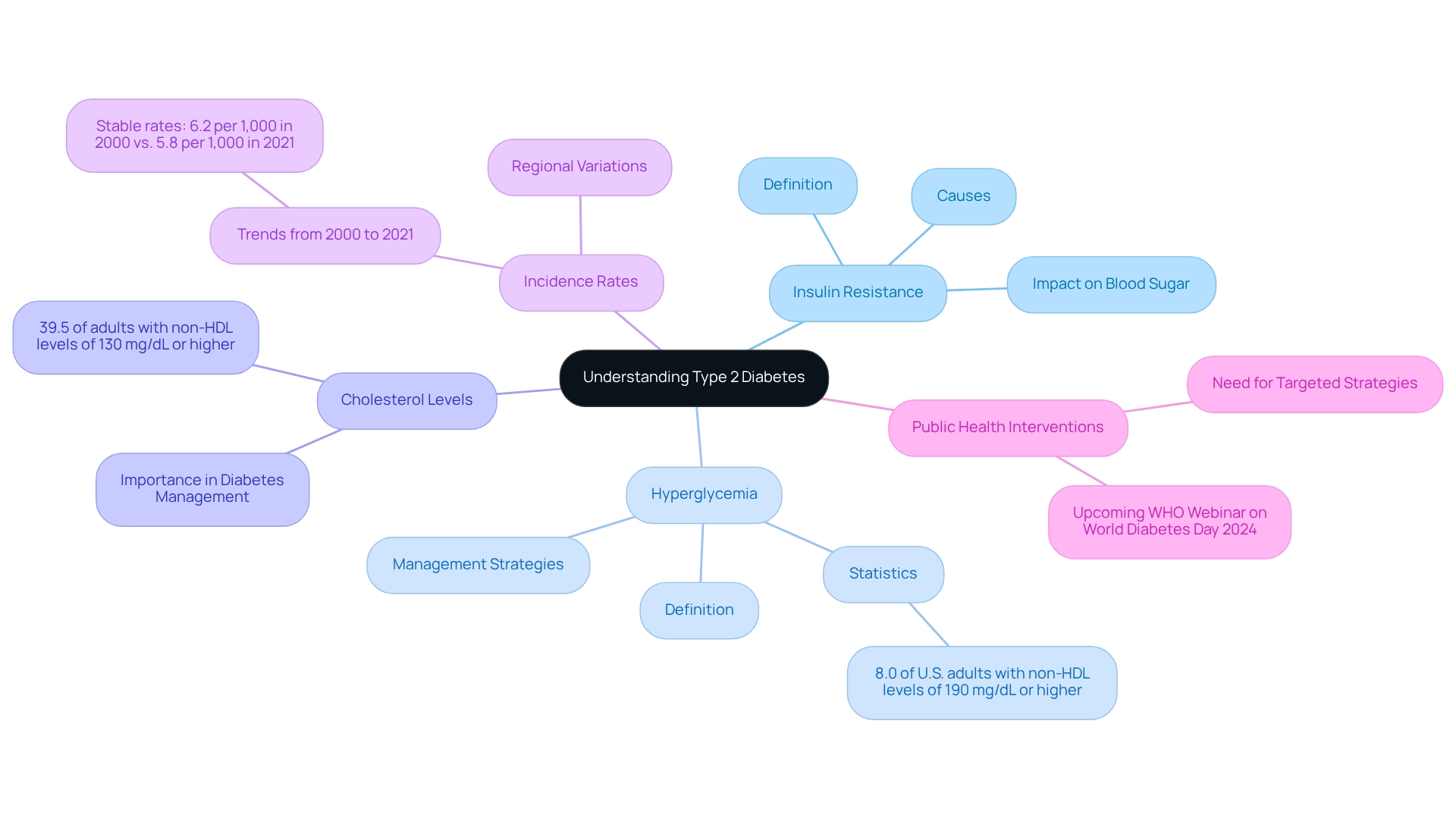
Recognizing the Symptoms of Type 2 Diabetes
To explain diabetes type 2, it’s important to recognize that common symptoms encompass a range of physical signs that can significantly impact daily life. These include:
- Increased thirst
- Frequent urination
- Extreme hunger
- Fatigue
- Blurred vision
- Slow-healing sores
Additionally, you may notice:
- Unexplained weight loss
- A higher frequency of infections
Recognizing these symptoms early is crucial, as it encourages individuals to seek medical advice for testing and diagnosis. It’s understandable to feel overwhelmed by these signs, but acknowledging them is the first step towards better health.
For example, increased thirst and urination are direct responses to elevated glucose levels in the bloodstream. The body attempts to eliminate excess glucose through urine, which can lead to dehydration and further exacerbate symptoms. Recent statistics indicate that nearly 47.4% of U.S. adults diagnosed with the condition have an A1C value of 7.0% or higher, highlighting the prevalence of these symptoms among those affected.
Moreover, average medical costs among individuals with diagnosed conditions related to blood sugar are 2.6 times greater than what expenses would be without such conditions, emphasizing the financial urgency of early symptom recognition and management.
Real-life experiences illustrate the urgency of symptom recognition. Many patients report that their journey to diagnosis began with increased thirst and frequent urination, prompting them to consult healthcare providers. This proactive approach is essential, as early diagnosis can lead to more effective management strategies and improved health outcomes.
A case study called "The Importance of Regular Health Check-ups" emphasizes this point, demonstrating that regular monitoring and consultations with healthcare professionals are essential for managing blood sugar levels and preventing complications.
At T2DSolutions, we understand the challenges faced by newly diagnosed patients. Our platform serves as a comprehensive resource hub for blood sugar management education and community support. We encourage you to subscribe to our updates to stay informed about the latest resources and strategies that explain diabetes type 2 and help manage it effectively.
Moreover, continuous education regarding these common symptoms can enable individuals to take control of their well-being. It’s important to emphasize the significance of:
- Lifestyle modifications
- Regular medical check-ups
- Blood sugar monitoring
in preventing complications linked to diabetes. By fostering a supportive community and encouraging proactive health management, you can significantly improve your quality of life. Remember, you're not alone in this journey; we are here to support you every step of the way.
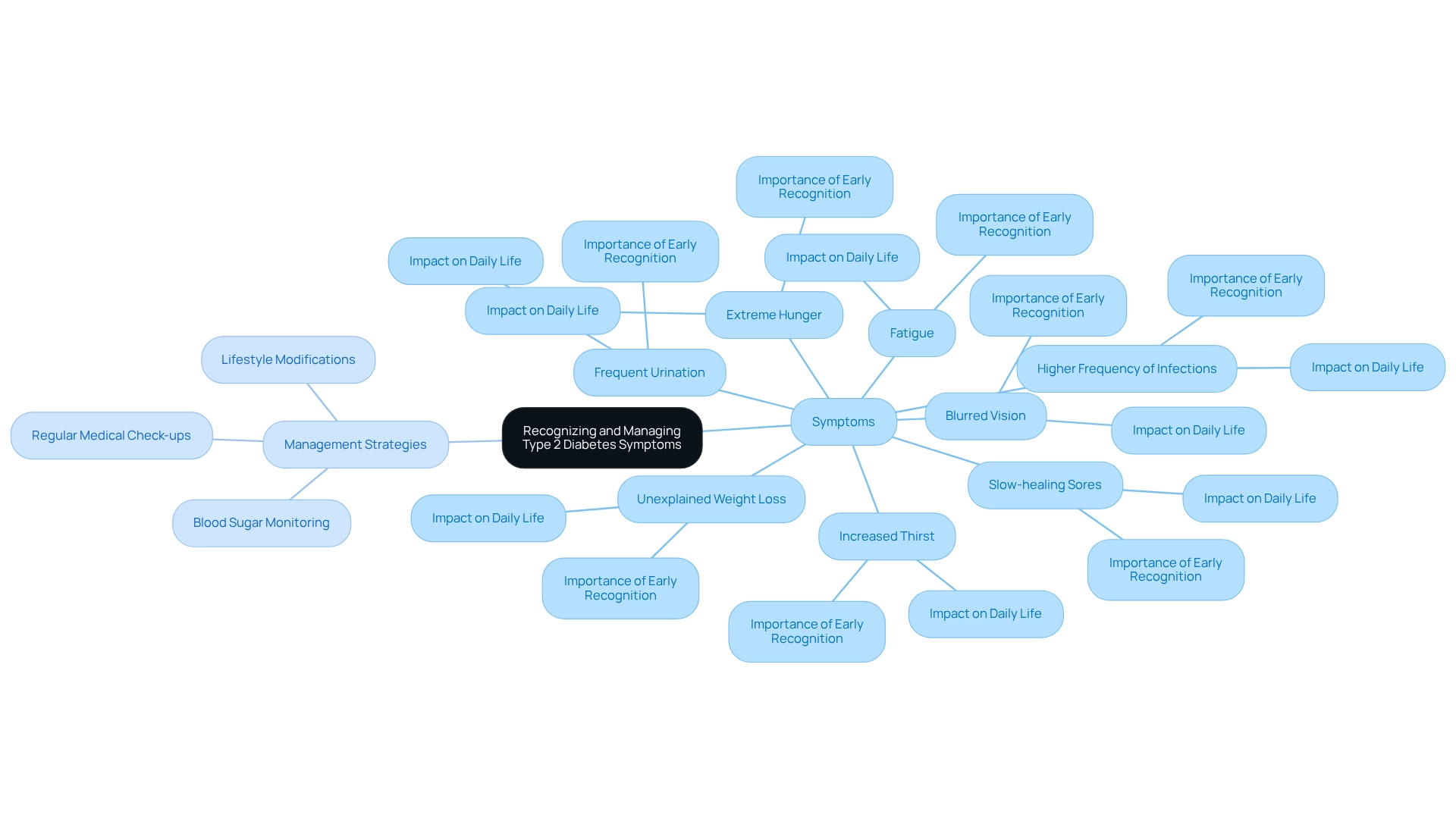
Identifying Risk Factors for Type 2 Diabetes
Numerous risk factors can significantly increase a person's chance of developing a form of diabetes, especially type 2 diabetes. It's important to recognize these contributors, which include:
- Being overweight
- Leading a sedentary lifestyle
- Being over the age of 45
- Having a family history of diabetes
Additionally, factors such as high blood pressure, elevated cholesterol levels, and conditions like polycystic ovary syndrome (PCOS) can further amplify this risk.
Recent statistics reveal a concerning trend: the prevalence of obesity, a major risk factor for insulin resistance, continues to rise. By 2025, nearly 42% of adults in the United States are projected to be classified as obese. This alarming statistic underscores the urgent need for effective lifestyle interventions. Many studies illustrate the connection between obesity and type 2 diabetes, showing that individuals with obesity are significantly more likely to develop this condition compared to those who maintain a healthy weight.
Understanding these risk factors is crucial for encouraging individuals to adopt healthier habits. Engaging in regular exercise and maintaining a balanced diet can play a vital role in preventing the development of type 2 diabetes. It's advisable for individuals to consult with a physician regarding any medical issues that may require intervention to lower their risk of developing this condition.
Moreover, case studies have highlighted the staggering economic impact of diabetes, with the total estimated costs of diagnosed diabetes in the U.S. reaching $412.9 billion in 2022. This figure includes $306.6 billion in direct medical costs, emphasizing the importance of preventive measures and effective management strategies to reduce both direct medical expenses and the indirect costs associated with lost productivity.
By recognizing and addressing these risk factors, individuals can take proactive steps toward improved health and potentially prevent the onset of a chronic condition. T2DSolutions aims to be a comprehensive resource hub for individuals seeking education and support in managing their condition. We provide valuable information and community resources to help you navigate this journey. Remember, you're not alone in this journey; we are here to support you every step of the way.
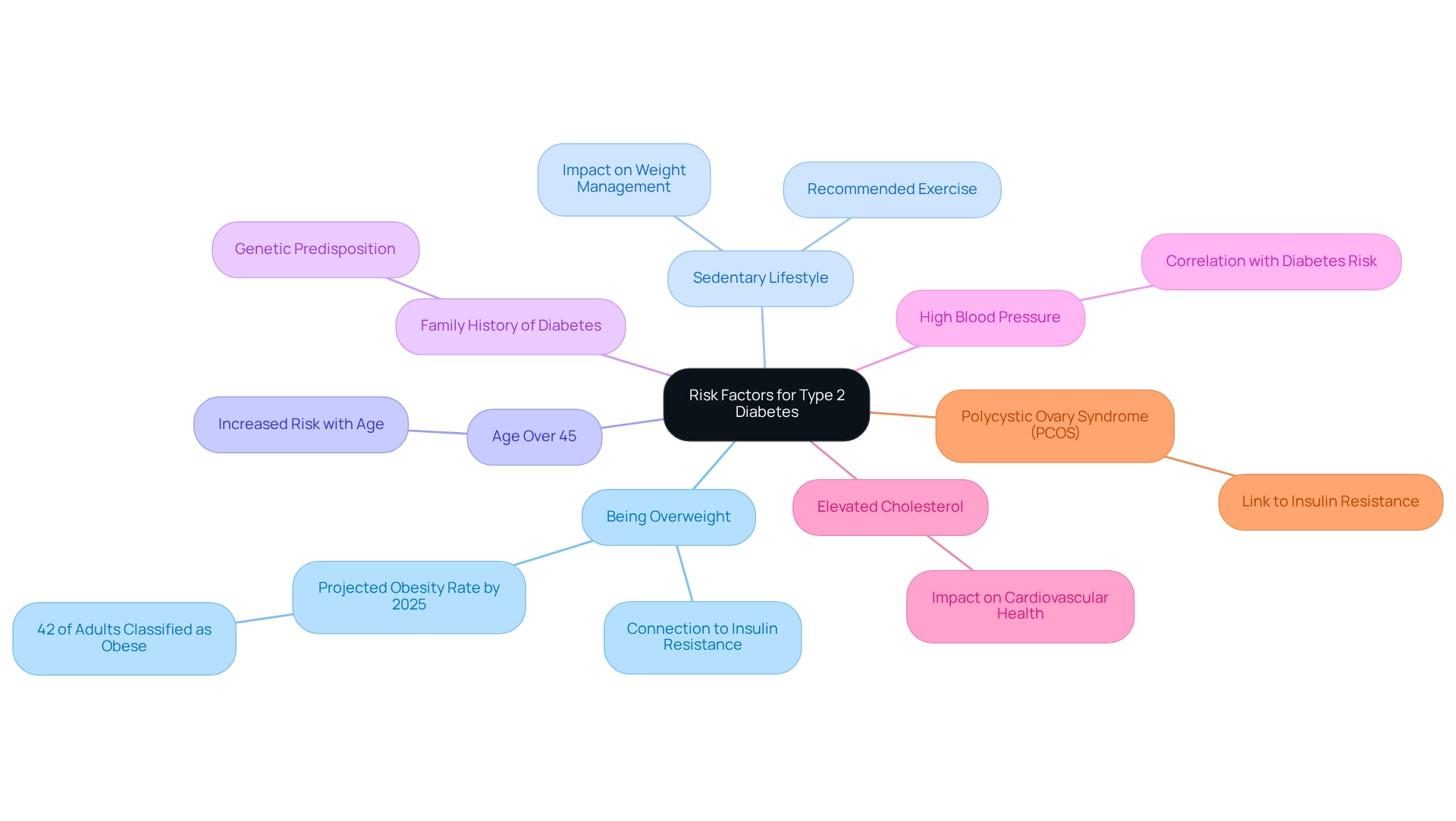
Diagnostic Criteria: How Type 2 Diabetes is Identified
When discussing diabetes type 2, it’s important to understand how it is diagnosed. The A1C test is a primary method, assessing typical blood sugar levels over the last two to three months. An A1C level of 6.5% or greater suggests the presence of this condition. Alongside the A1C test, healthcare professionals may use fasting plasma glucose tests, where a result of 126 mg/dL or greater indicates the condition.
Another common diagnostic method is the oral glucose tolerance test (OGTT). This test checks blood sugar levels two hours after consuming a sugary drink. It's crucial for patients to familiarize themselves with these tests, as it empowers them to explain diabetes type 2 effectively to their healthcare providers. For instance, recent data shows a decrease in the median county-level incidence of diagnosed health conditions from 9.7 per 1,000 individuals in 2004 to 9.0 per 1,000 individuals in 2020. This reflects advancements in awareness and management strategies.
Additionally, a notable case study from 2021 indicated that around 97.6 million Americans aged 18 and older were estimated to have prediabetes. This statistic emphasizes the significance of early detection and intervention. The high prevalence of prediabetes highlights the urgent necessity for public welfare initiatives that explain diabetes type 2 and focus on preventing its advancement.
Furthermore, average medical costs among individuals with diagnosed blood sugar issues were 2.6 times greater than what costs would be without these conditions. This underscores the financial impact of effective management. As of 2025, the diagnostic criteria for this type of blood sugar disorder remain unchanged, with the A1C test continuing to play a crucial role in diagnosis.
Education on blood glucose management and lifestyle changes is vital for preventing complications. By understanding these tests and their implications, patients can take proactive steps in managing their health. Remember, you’re not alone in this journey. Collaborating with your healthcare team can make a significant difference in your path to wellness.

Effective Management Strategies for Type 2 Diabetes
To effectively manage type 2 diabetes, it’s essential to understand the condition through a compassionate lens. This involves a multifaceted approach that includes:
- Lifestyle changes
- Medication adherence
- Regular monitoring of blood sugar levels
At T2DSolutions, we encourage our patients to embrace a balanced diet rich in:
- Whole grains
- A variety of fruits and vegetables
- Lean proteins
While minimizing processed foods and added sugars. Research shows that lifestyle intervention programs can significantly prevent or delay the onset of diabetes in high-risk groups, highlighting the critical role of dietary choices in managing this condition.
Incorporating regular physical activity into your daily routine—whether it’s walking, swimming, or cycling—can greatly enhance blood sugar control. Engaging in at least 150 minutes of moderate-intensity exercise each week is recommended, as it not only helps with weight management but also improves insulin sensitivity. At T2DSolutions, we provide the resources and guidance necessary to help you establish and maintain these healthy habits.
Adhering to prescribed medications, such as metformin, is crucial for maintaining optimal blood sugar levels. Recent data indicates that medication adherence rates among individuals with type 2 diabetes can be improved through wellness information technologies, which support prevention strategies and encourage positive behavior changes. Regular consultations with healthcare providers are essential for monitoring your progress and making necessary adjustments to your management plan, and T2DSolutions is here to facilitate those important connections.
Real-life examples demonstrate the effectiveness of these strategies; many patients have successfully improved their blood sugar control through dedicated lifestyle changes. For instance, a recent case study revealed that nearly half of participants reported making significant lifestyle changes based on information they found online, showcasing the potential of digital resources in promoting positive health behaviors. Anne Helen Hansen from the Department of Community Medicine emphasizes that "internet and online groups hold an important potential to provide information and support when people are ready for it, and in the way they prefer."
However, the study also highlighted a low participation rate in online support groups, indicating a need for increased engagement to fully realize the benefits of such platforms. T2DSolutions aims to enhance this engagement by offering accessible online support and resources.
As we move toward 2025, the latest recommendations for managing type 2 diabetes stress the importance of a comprehensive strategy that includes not only dietary and exercise changes but also mental well-being support and community involvement. Community-oriented lifestyle initiatives have shown promise in reducing the incidence of blood sugar-related conditions and improving overall wellness outcomes, emphasizing the need for a thorough management approach. Insights from health educators underscore the significance of fostering a supportive environment where individuals can share their experiences and strategies, ultimately leading to better health outcomes for everyone involved.
At T2DSolutions, we are dedicated to being that supportive resource for newly diagnosed patients, providing the tools and community you need to thrive. Remember, you’re not alone in this journey—we are here to support you every step of the way.

The Role of Diet and Exercise in Managing Type 2 Diabetes
Diet and exercise are essential elements in effectively managing Type 2 diabetes. A well-balanced diet plays a crucial role in regulating blood sugar levels and achieving a healthy weight. It's important to focus on a variety of foods, especially those with a low glycemic index, as they help prevent spikes in blood sugar.
Recent studies show that dietary choices significantly impact blood sugar control. Evidence indicates that a balanced diet can lead to improved glycemic outcomes. Notably, the total direct estimated expenses for diagnosed conditions rose from $227 billion in 2012 to $307 billion in 2022. This highlights the importance of effective management for both health and financial well-being.
When it comes to physical activity, the current recommendation is to engage in at least 150 minutes of moderate-intensity exercise each week. Activities such as brisk walking, cycling, and strength training have all been shown to enhance insulin sensitivity and support weight management. As Felipe Lobelo, MD, PhD, FAHA, from the Emory Global Diabetes Research Center, states, "the incorporation of physical activity into standard medical care and fostering clinical-community connections is crucial for enhancing outcomes for individuals with blood sugar disorders."
Individuals who integrate regular physical activity into their routines often report enhanced wellness results, including increased energy levels and decreased dependence on medication. It’s understandable to feel overwhelmed, but remember, you’re not alone in this journey.
Moreover, the integration of diet and exercise is vital for achieving optimal results. Case studies reveal that individuals who embrace a comprehensive approach—combining healthy eating habits with regular physical activity—experience substantial improvements in their overall health and blood sugar management. For instance, the case study titled "Challenges in Implementing Lifestyle Diabetes Prevention" emphasizes the importance of collaboration with community programs and training for healthcare providers to improve lifestyle changes.
Furthermore, the World Health Organization (WHO) is dedicated to promoting effective strategies for monitoring, prevention, and management of diabetes-related issues, particularly in low- and middle-income nations. This involves offering scientific guidelines and increasing awareness about the condition, which underscores the global context of management strategies.
In summary, embracing a balanced diet alongside regular exercise is crucial for managing Type 2 diabetes while enhancing overall well-being. By making informed dietary choices and committing to an active lifestyle, patients can take significant strides toward better health. T2DSolutions will serve as a valuable resource center, providing educational materials and community support to assist you in managing your condition effectively. We are here to support you every step of the way.
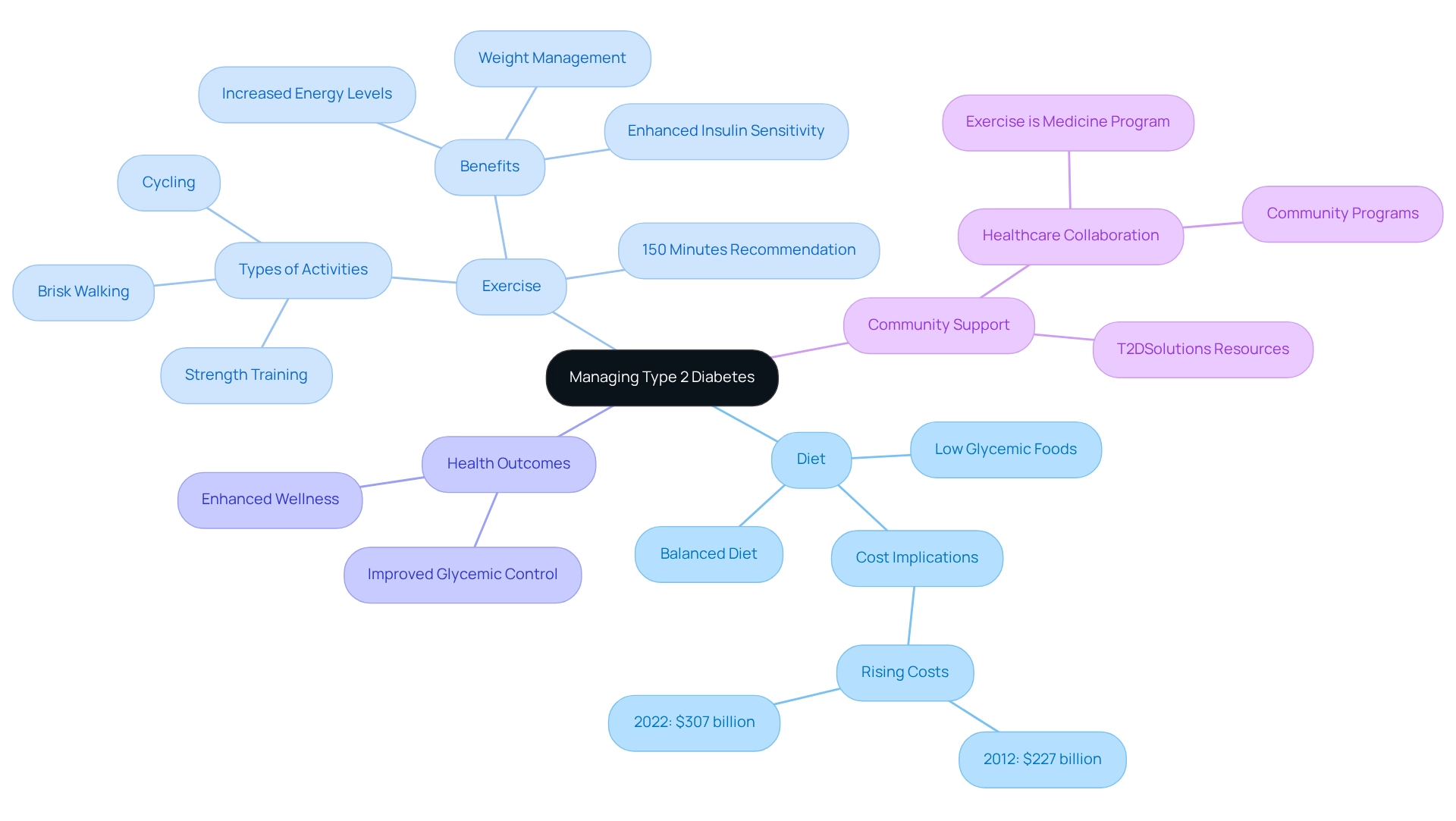
Mental Health and Emotional Support for Diabetes Patients
Coexisting with the second type of sugar metabolism disorder can often bring about significant emotional challenges, including anxiety, depression, and distress related to the condition. Research indicates that adults with depression face a 37% increased risk of developing Type 2 diabetes, highlighting the interconnectedness of these conditions. It's essential for patients to actively seek emotional support from medical providers, support groups, or mental wellness experts to address these challenges effectively.
T2DSolutions serves as a valuable resource hub, offering educational materials and support networks specifically designed for newly diagnosed patients. This support can help individuals navigate the emotional complexities they may encounter.
Engaging in stress-reducing activities such as mindfulness, yoga, or counseling can greatly enhance emotional well-being. For instance, a case study on incorporating mental wellness services into blood sugar management underscores the importance of mental wellness screening in related clinics. Given the high prevalence of mental wellness comorbidities among patients with blood sugar issues, this integration not only improves patient outcomes but also reduces healthcare costs. It emphasizes the vital role of addressing mental well-being in managing blood sugar conditions.
Barbara J. Anderson, PhD, from the Department of Pediatrics at Baylor College of Medicine, notes, "The high prevalence and costs of depression in the context of this illness, combined with evidence that behavioral factors are important for effective self-management of the condition, create an important opportunity to integrate mental well-being screening and treatment into multidisciplinary team care for this disorder."
Building a strong support network of family and friends can provide essential encouragement and understanding, helping patients navigate the emotional complexities of managing their condition. Insights from psychologists highlight that emotional support is crucial for patients facing diabetes-related issues, as it fosters resilience and coping strategies. By prioritizing mental health and embracing a holistic approach that includes community support and lifestyle changes, individuals can enhance their overall quality of life while also seeking to understand Type 2 diabetes.
T2DSolutions is committed to providing the necessary resources and support to empower patients on their journey. Remember, you're not alone in this journey; we are here to support you every step of the way.
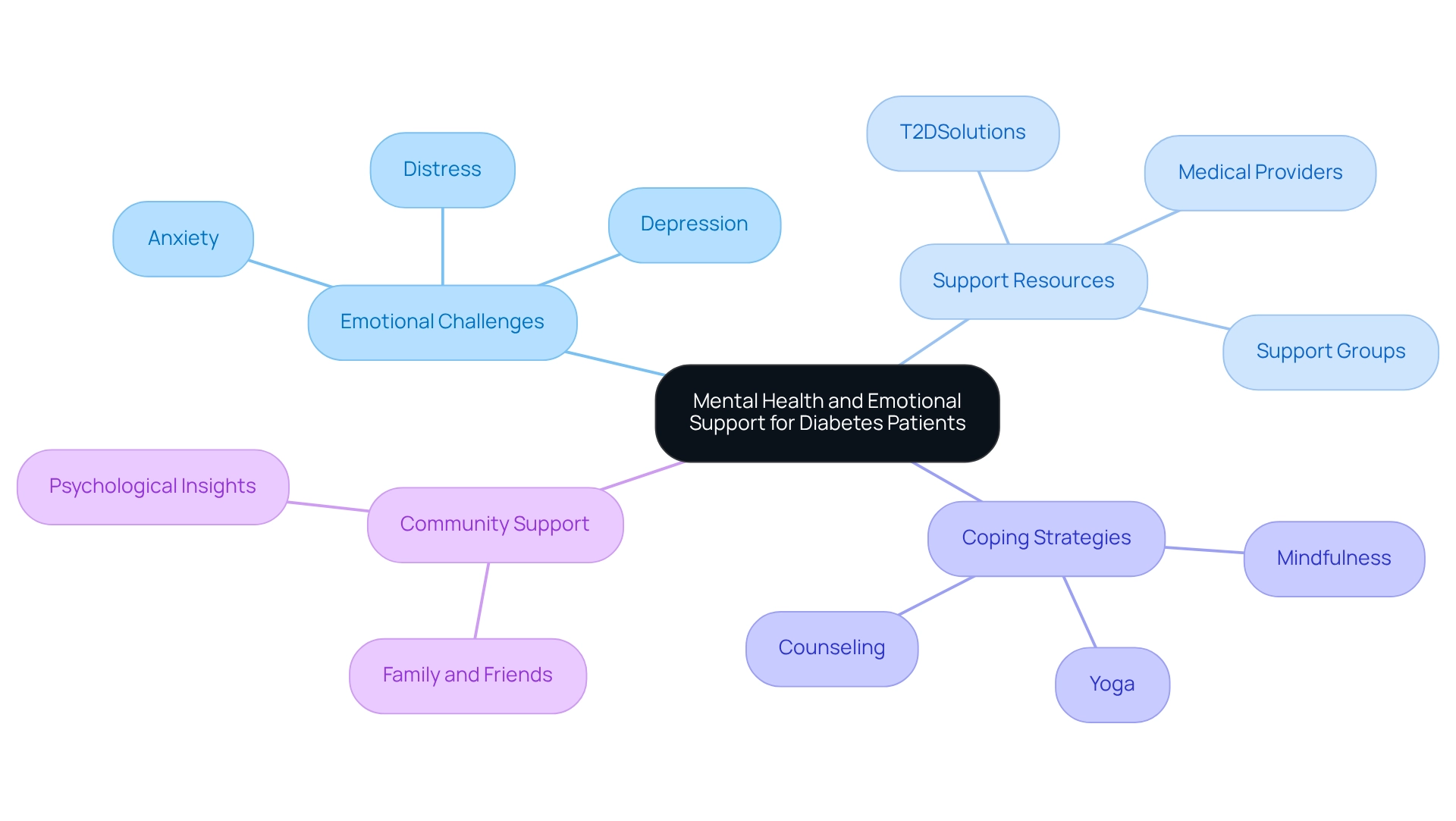
Building a Supportive Community for Diabetes Management
Creating a supportive community is essential for effectively managing diabetes-related issues, and T2 Solutions is here to help you understand type 2 diabetes and assist you on this journey. Engaging with local support groups, participating in health education programs, or connecting with online communities can significantly enhance your experience. These platforms not only provide opportunities to share experiences and learn from others but also offer essential encouragement during challenging times.
It's understandable to feel overwhelmed, but recent statistics suggest that individuals who join support groups for managing blood sugar experience enhanced self-care and maintain better glycemic control. For instance, a recent study highlighted that ongoing peer support over four years led to notable enhancements in self-management practices among participants. During this voluntary 3-year extension period, peer supporters met every six months with the project team, demonstrating a structured commitment to support.
Real-world examples illustrate the impact of community engagement. Individuals participating in health education programs frequently express feeling more empowered and knowledgeable about how to explain type 2 diabetes. A subgroup analysis revealed that interventions were particularly effective for individuals with lower baseline HbA1c levels, underscoring the importance of tailored support.
This analysis showed a larger effect size in studies with participants having baseline HbA1c levels below 8.5%, indicating that interventions may be more effective for these individuals.
Additionally, community resources such as health fairs and workshops provide valuable information and foster connections among individuals facing similar challenges. Interacting with others not only fosters resilience but also establishes a sense of belonging, which is essential for long-term management of the condition. As health advocate Margaret A. Powers states, "Quality ongoing, routine care includes continuous assessment, ongoing education and learning, self-management planning, and ongoing support." This highlights the instrumental role of support groups in building a network of understanding and shared knowledge that can help explain type 2 diabetes and enhance overall health outcomes.
In 2025, the emphasis on developing community support for managing blood sugar conditions continues to increase, with expert views underscoring the necessity for joint efforts to enhance patient assistance. T2 Solutions strives to be an all-encompassing resource center to explain type 2 and Type 3 conditions, providing education and community assistance while featuring upcoming events and initiatives intended to involve and empower individuals. Future investigations should examine further traits such as study environment and participants' educational attainment, highlighting the changing dynamics of management.
By actively seeking out and engaging in these supportive environments, you can significantly improve your health management journey. Remember, you're not alone in this journey; we are here to support you every step of the way.
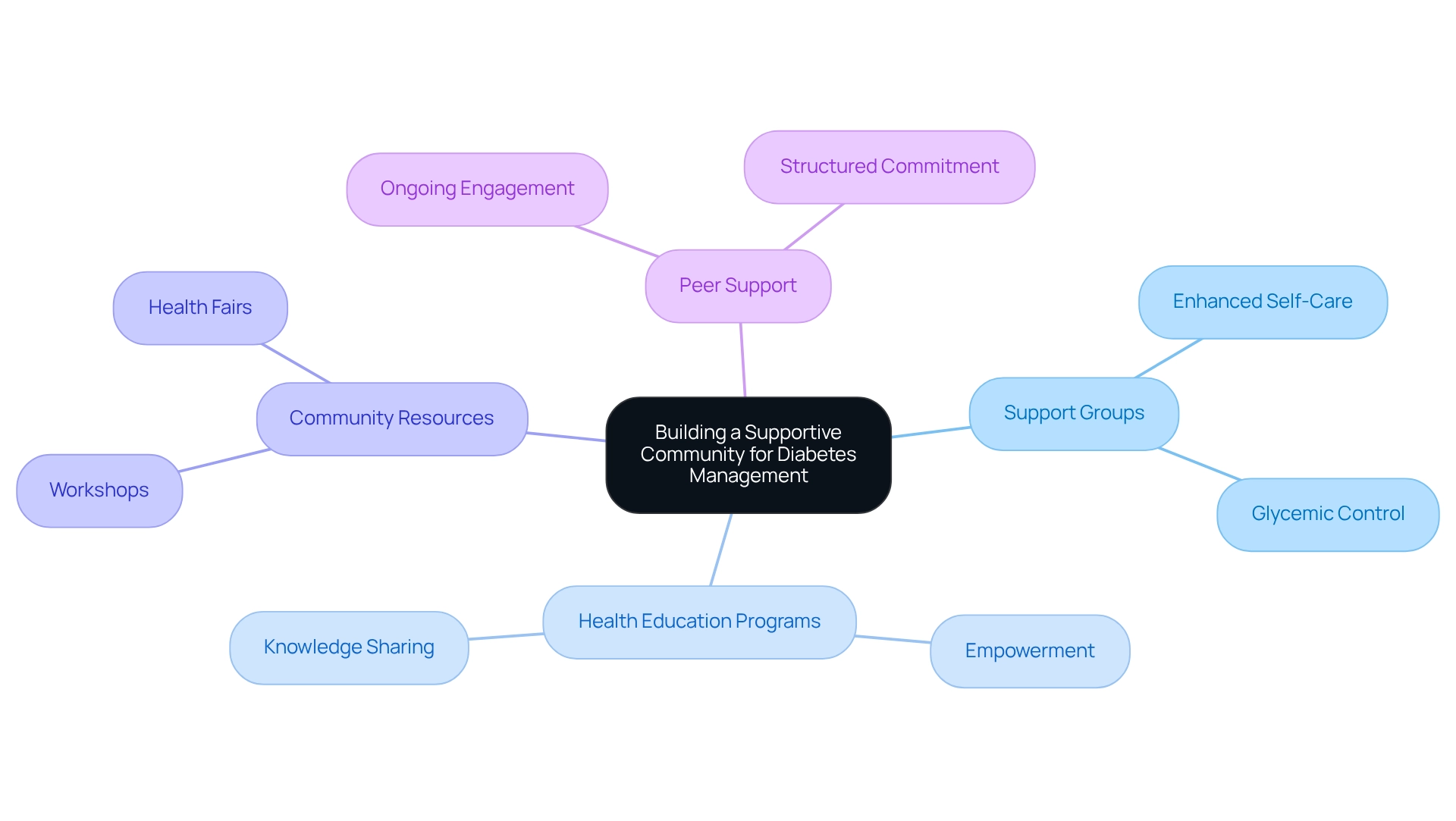
Latest Research and Innovations in Type 2 Diabetes Treatment
At T 2 Solutions, we are truly dedicated to being a complete resource center for managing chronic health conditions and providing community assistance. Recent advancements in Type 2 Diabetes treatment aim to explain diabetes type 2 through a range of new medications, innovative technologies, and lifestyle interventions that significantly enhance patient care. Notably, medications such as GLP-1 receptor agonists and SGLT2 inhibitors have emerged as effective options, demonstrating substantial improvements in blood sugar control and reductions in cardiovascular risks.
For example, research shows that these medications not only assist in regulating glucose levels but also lead to improved overall wellness outcomes. It's understandable to feel overwhelmed by the options available, but know that you are not alone in this journey.
Alongside pharmacological advancements, continuous glucose monitoring (CGM) technology has transformed diabetes care. This innovative tool allows patients to track their blood sugar levels in real-time, facilitating more precise adjustments to their treatment plans. Current data indicates that patients utilizing CGM technology experience enhanced glycemic control and increased involvement in their wellness management.
Furthermore, a longitudinal analysis of medication supply and use revealed that insulin remains the most commonly prescribed medication, with an average annual supply of 269 days. However, the study also highlighted concerning trends in medication adherence, underscoring the importance of consistent use to prevent worsening health outcomes. The analysis found that gaps in adherence could lead to increased medical costs, which have risen from $10,179 per person in 2012 to $12,022 in 2022, emphasizing the financial impact of managing the condition.
As for treatment recommendations, the American College of Physicians (ACP) advises against adding a dipeptidyl peptidase-4 (DPP-4) inhibitor to metformin and lifestyle modifications in adults with Type 2 and inadequate glycemic control, citing strong evidence for this guidance. Furthermore, the CGC Public Panel chooses not to utilize DPP-4 inhibitors because of insufficient advantages relative to SGLT-2 inhibitors or GLP-1 agonists, offering a contemporary viewpoint on medication options. As the field of managing blood sugar conditions progresses, remaining updated on these changes is essential.
At A2D Solutions, we encourage you to engage in discussions with healthcare providers about the latest research and treatment options. By understanding the advancements in blood sugar medications and technologies, you can better explain diabetes type 2 and take proactive steps in managing your condition effectively. We invite you to explore our resources and stay connected for more information on diabetes management.

Conclusion
Understanding Type 2 Diabetes is essential for effective management. Key concepts like insulin resistance and hyperglycemia highlight the need for early detection and intervention. Recognizing symptoms such as increased thirst and fatigue is crucial for seeking timely medical advice, which can significantly improve health outcomes. Awareness of risk factors, including obesity and family history, empowers individuals to adopt healthier lifestyle choices that may prevent diabetes.
Effective management involves a comprehensive approach that combines diet, exercise, medication adherence, and mental health support. A balanced diet and regular physical activity are vital for controlling blood sugar levels and enhancing overall well-being. Addressing emotional challenges related to diabetes is equally important, as mental health significantly impacts self-management and quality of life.
Building a supportive community plays a crucial role in successful diabetes management. Engaging in local support groups and online resources fosters a sense of belonging and offers encouragement. Recent advancements in treatment, including new medications and technologies, provide promising options for better diabetes care. Staying informed about these innovations empowers individuals to take proactive steps in managing their condition.
In summary, while managing Type 2 Diabetes can be challenging, it is a journey that can be navigated effectively with the right education, support, and resources. Embracing a holistic approach that includes lifestyle changes, emotional support, and community engagement is essential for improving health outcomes. Remember, you're not alone in this journey. T2DSolutions is dedicated to providing the tools and resources necessary to empower you in your diabetes management journey. We are here to support you every step of the way.
Frequently Asked Questions
What is diabetes type 2 and how does it develop?
Diabetes type 2 is a long-term condition characterized by insulin resistance, where the body struggles to use insulin effectively, leading to higher blood sugar levels. It often develops gradually and is commonly linked to obesity.
What is insulin resistance?
Insulin resistance occurs when the body's cells become less responsive to insulin, the hormone that regulates blood sugar. As resistance increases, the pancreas may have difficulty producing enough insulin, resulting in elevated blood sugar levels.
What is hyperglycemia?
Hyperglycemia refers to elevated blood sugar levels. It is a common condition among individuals with diabetes, indicating the need for effective management strategies.
What are some common symptoms of diabetes type 2?
Common symptoms include increased thirst, frequent urination, extreme hunger, fatigue, blurred vision, slow-healing sores, unexplained weight loss, and a higher frequency of infections.
Why is early recognition of diabetes symptoms important?
Early recognition of symptoms is crucial as it encourages individuals to seek medical advice for testing and diagnosis, leading to more effective management strategies and improved health outcomes.
What are the risk factors for developing diabetes type 2?
Risk factors include being overweight, leading a sedentary lifestyle, being over the age of 45, having a family history of diabetes, high blood pressure, elevated cholesterol levels, and conditions like polycystic ovary syndrome (PCOS).
How does obesity relate to diabetes type 2?
Obesity is a major risk factor for insulin resistance, and individuals with obesity are significantly more likely to develop type 2 diabetes compared to those with a healthy weight. The prevalence of obesity is projected to rise, highlighting the need for effective lifestyle interventions.
What are the economic impacts of diabetes in the U.S.?
The total estimated costs of diagnosed diabetes in the U.S. reached $412.9 billion in 2022, including $306.6 billion in direct medical costs, emphasizing the importance of preventive measures and effective management strategies.
What proactive steps can individuals take to manage their health regarding diabetes type 2?
Individuals can engage in regular exercise, maintain a balanced diet, and consult with a physician regarding any medical issues that may require intervention to lower their risk of developing diabetes type 2.
How can T2DSolutions assist individuals managing diabetes type 2?
T2DSolutions serves as a comprehensive resource hub for blood sugar management education and community support, providing valuable information and resources to help individuals navigate their health journey.
